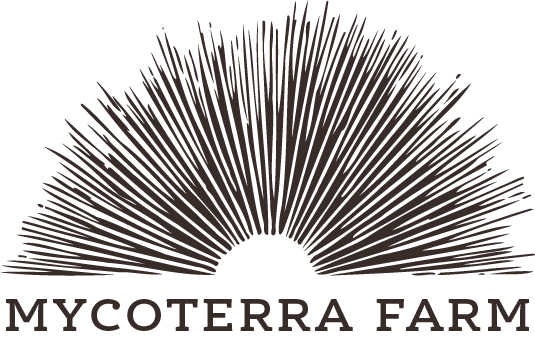
Download these instructions as a pdf.
Shop Mycoterra Farm’s Mushroom Plug Spawn
Contained in the bag are spiral grooved birch dowels that have mycelium living throughout each one. Mycelium is the vegetative stage of the mushroom life-cycle; the mushrooms are the fruit. You may also find some millet grains covered in mycelium, which was used as spawn to transfer the mycelium to the dowel. The dowels are now ready to be used as spawn to transfer the mycelium further into hardwood logs. Propagating mycelium is more consistent, reliable and faster than growing mushrooms from spores.
You will need:
- 30-50 plugs, depending on size of logs
- Drill, high-speed preferable
- 3/8″ drill bit
- Wax
- Small brush for applying wax
- Hot plate or other means to melt the wax
- Wacker (mallet, hammer, 2/4, etc.)
- 2-3 hardwood logs1
- 4-8″ diameter (up to 12″ diameter is okay) up to 4 feet long.
Instructions
- Drill holes 2 inches deep, spaced 3-4 inches apart in rows along the length of the log. Space rows 4-6 inches apart. The first plug should be no closer than 1 inch from the end of the log. Aim for triangular or diamond spacing between rows to maximize distribution of plugs throughout the log. Drill your holes at the time of inoculation; if you drill them in advance you are inviting other fungi and contaminants into the log.
- With clean hands, remove enough plugs for one log at time, being sure to seal the bag in between. This helps prevent cross-contamination.
- Insert a plug into each hole, using your wacker to help assist with this task. Be sure the plugs are set just inside the outer bark, in contact with the rich cambium layer. Do not push the plugs to the bottom of the holes, as the airspace allows the mycelium room to initially establish in the log.
- Carefully heat wax on your hot plate, double-boiler or burner. A crock-pot can be used, but be prepared to dedicate the device to wax for eternity! Coat each inoculation site with hot wax, sealing the plug in the hole.
- Place your logs in a shaded, moist area2 However, it is helpful to place them in a convenient location for watering3 and regular observation4 To prevent encroachment of competitor fungi on your logs, avoid contact with soil. Logs can be stacked Lincoln-log style on pallets, lumber, rocks or un-inoculated logs.
- BE PATIENT! It can take 1-2 years before you harvest your first crop of mushrooms. First, the mycelium must grow through the log and accumulate sufficient nutrients to support a crop of mushrooms. Under ideal conditions, you may harvest some mushrooms in less than a year, just don’t be disappointed if it takes a while.
Notes
- Red and white oak are ideal; other oak species are also excellent. Thick barked hardwood trees, like ash and maple are also suitable. Paper barked trees may work, but won’t last as long as the bark protects the mycelium while growing on the log. Logs should be fresh-cut and aged at least 2 weeks and up to 2 months, as trees produce natural anti-fungal compounds that dissipate with aging. Logs outside this range can be used, but will have less reliable results. Older logs are not suitable as they are often too dry and, more importantly, other fungi are likely already living on them. Avoid logs, even fresh ones, with any signs of rot or other fungi. Be sure to keep the logs off the ground while aging, as competitor fungi will readily begin growing into the logs from the soil.
- If you complete your inoculation at least 30 days before freezing temperatures set in, the mycelium will be established enough to over-winter outdoors. However, winter inoculations are one of our favorite basement activities! If it is frigid after you have inoculated your logs, just protect them from heavily freezing temperatures by placing them in a basement, garage or greenhouse. Remember to move your logs outside in the spring to their permanent location.
- It is important to not let your logs dry out. In the case of a dry spell, water with a hose or sprinkler at least once a week.
- Inspect the ends of the logs for signs of mottling or spalting; this indicates the degree of colonization. Once the ends of the logs show signs of mycelial growth, you can force initiate mushrooms by soaking your logs for about 24-hours in fresh, non-chlorinated water. This provides an environmental shock and is especially successful when done within the ideal fruiting temperature range of 50-750 F. After soaking, be sure your logs get regular water to support mushroom development. Once you harvest your first crop, your logs can continue to produce for 4-8 years. Small logs will produce a crop faster, but won’t last as long as larger logs. Once the bark falls off and the logs appear mostly rotted, they have likely come to the end of their production. Place them in contact with the forest floor so their nutrients can continue to be recycled.

